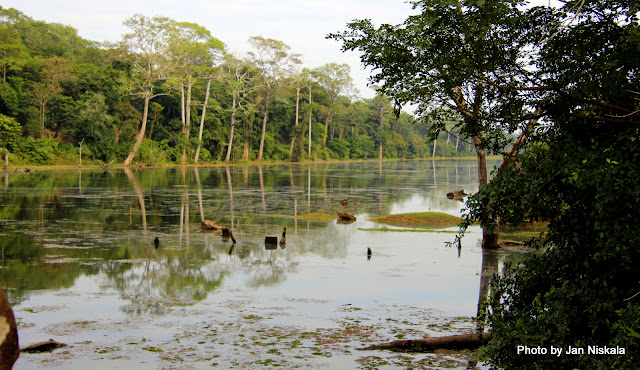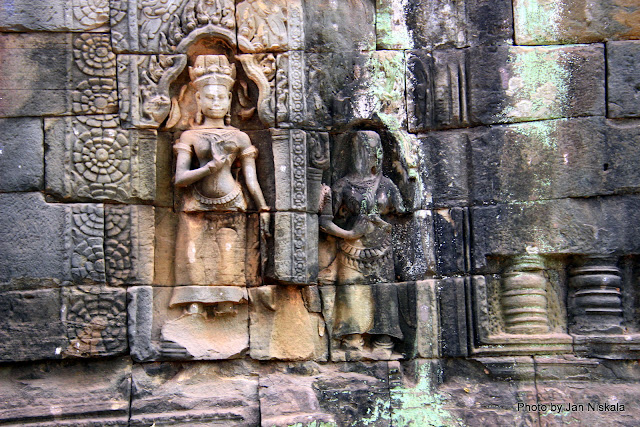Siem
Reap, Gateway to Angkor Temples
There
are many Temples in Cambodia but we only went to the city of Siem Reap where we
were able to visit the Ankgor Thom complex, the sprawling remains of the Kymer reign. Angkor Wat and Angkor Thom are
designated as one of the Seven Wonders of the World. "Angkor" means 'city' and "Thom" means 'big'; so, Angkor Thom refers to what once was a great Khmer city and includes a whole host of temples and sites of historical interest. The Angkor Thom Temples we visited included Bayon
Temple, Ta Prohm, and Angkor Wat.
The tranquil
stone faces of Bayon Temple, a highlight of Angkor Thom, are some of the most recognizable images
from the Angkor Archeological Park. Another interesting and unexpected sight
at this location is the monkeys, including a couple of babies, running around
the property and living in the trees.
Bayon
was the symbolic center of the Khmer Empire. Dedicated to Buddha by King Jayavarman VII, this state temple was originally called “Jayagiri” (which
means “Victory Mountain”) but was renamed “Bayon Temple” sometime after the French
occupancy. The Buddha is said to have
attained enlightenment after a long period of meditation beneath a banyan tree.
The religious significance of the banyan tree and the many banyan trees growing
around the site made it an appropriate name. However, the local Khmer who
worked on the restoration of the temple were responsible for its final name
change. The workers mispronounced the name as “Bayon” instead of “Banyan” and
the name stuck.
In
addition to the 216 giant stone faces smiling down at you from every
direction, the site also includes an impressive array of well-preserved
bas-relief carvings depicting an unusual combination of scenes from
history, mythology, and everyday life.
The Bayon temple rises through three levels to a height of around 140
feet. The outer gallery on the first
level depicts scenes from everyday life and historical events, while the inner
gallery on the next higher level depicts mythical figures and stories. Some of
the figures depicted are Siva, Vishnu, and Brahma, Hindu Gods.
We exited the Bayon and Angkor Thom via the Elephant terrace.
Next we visited Ta Prohm. I’m
sure everyone will recognize this Temple once you see the photos. Ta Prohm is absolutely beautiful, as well as one
of the most photogenic ruins within the Angkor Temples, with trees growing out
of the ruins. You can imagine yourself
as India Jones or Tomb Raider as you explore this unusual place. If Angkor Wat
and other temples are a testimony to the genius of the ancient Khmers, Ta Prohm
equally reminds us of the awesome power of the jungle.
Built from 1186, Ta Prohm was a Buddhist Temple dedicated to the mother
of Jayavarman VII. It is one of the few temples in Angkor where an inscription
provides information about the temple’s inhabitants. The temple was home to
more than 12,500 people, including 18 high priests, while an additional 80,000
Khmers, living in the surrounding villages, were required to maintain the
temple. The inscription also notes that the temple contained gold, pearls and
silks. After the fall of the Khmer empire in the 15th century, the temple was
abandoned and swallowed up by the jungle.
The holes in the walls here are said (by our guide) to be filled with precious gems for the Queen. As you would imagine, they have all long since been removed by thieves.
Our guide explained that the existing trees (Strangler Fig) in ancient times, while the jungle was taking back this land, the seeds would drop off the trees and land on the ruins. The seeds began to grow and what you see growing down and around the ruins today are the roots of those trees.
Ta Prohm is included
in “the big three temples” along with Angkor Wat and Angkor Thom. It is a mesmerizing
temple to visit. Due to the jungle/ruin
take over the decision not to clear the historical site of trees, leaving some
of the most impressive jungle/ruin take-overs in place, was made when it was
decided to restore Ta Prohm for tourism and historical value. Restoration continues today as there are many
areas of the temple that have experienced rock falls and damage from years of
jungle growth.
On our way out of Ta Prohm there was the cutest little girl, all by
herself, sitting on a rock. While we did
not see any adult nearby I would hope there was one!
More coming soon 😊
Jan 🌷🌷🐾🐾














































































































































No comments:
Post a Comment